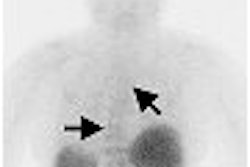Endometrial cancer is the fourth most common cancer in women, accounting for approximately 6,000 deaths per year in the U.S. It tends to strike most often in women who are older, white, affluent, obese, and of low parity.
The treatment regimen for endometrial carcinoma can include radiation therapy, but its use is fairly recent, and not without some controversy. Six years ago, there was still uncertainty as to whether radiotherapy had any value, mostly because of a lack of randomized trials to validate its use. That's where the Post Operative Radiation Therapy in Endometrial Carcinoma (PORTEC) trial stepped in, addressing many unanswered questions about radiation treatment in this disease.
In brief, the PORTEC data from the multicenter study showed that the risk of locoregional recurrence decreased significantly with radiation therapy but without a survival advantage (Lancet, April 22, 2000, Vol. 355:9213, pp. 1404-1411).
Over the years, the PORTEC group has expanded on their initial findings. A 2001 study compared treatment complications in stage I patients treated with surgery and pelvic radiotherapy or surgery alone (International Journal of Radiation Oncology, Biology, Physics, December 1, 2001, Vol. 51:5, pp. 1246-1255).
A 2003 paper looked more closely at the rates of local control and survival after relapse. A year later, the group published their results for women who were not eligible for the PORTEC study, namely high-risk stage IC/grade 3 patients (Gynecologic Oncology, May 2003, Vol. 89:2, pp. 201-209; Journal of Clinical Oncology, April 1, 2004, Vol. 22:7, pp. 1234-1241).
In all cases, the study outcomes drove home the initial PORTEC finding -- radiation therapy significantly reduced the rate of locoregional recurrence, but without an overall survival benefit.
Now in a fourth study, the PORTEC group has re-examined its initial data, taking into consideration how shifts in pathologic grade may have affected their results.
And in a separate paper, Utah-based cancer specialists found that the more advanced the disease, the more benefit patients saw from adjuvant therapy. While they unearthed a statistical association between survival and radiation treatment, they stopped short of dubbing it a causal relationship.
Locoregional control
On the plus side, the PORTEC group concluded that pelvic radiotherapy did have value in women who faced a sufficiently high risk for relapse by maximizing local control and relapse-free survival.
Unfortunately, there was a small glitch with the study design: Eligible patients had to have stage IC/grade 1 endometrial carcinoma with deep myometrial invasion or stage IB/grade 2-3 disease with superficial myometrial invasion. But during a later pathology review, there was a shift from grade 2 to grade 1 in several patients for a final diagnosis of stage IB/grade 1 tumor with superficial myometrial invasion. As a result, these patients would not have met the original PORTEC inclusion criteria.
To address this issue, the PORTEC study group went back to their data to see if exclusion of these favorable cases would alter the trial's original outcome. Lead author Dr. Astrid Scholten and colleagues, all from various institutions in the Netherlands, obtained pathology slides from 569 or 80% of the PORTEC patients. Overall survival and locoregional recurrence rates were calculated using the Kaplan-Meier method. The median follow-up time for patients who were still alive was about eight years.
According to the results, locoregional disease recurred in 13 patients assigned to radiotherapy for a 10-year actuarial locoregional relapse rate of 5%. Recurrence occurred in 47 patients who underwent observation for a 14% relapse rate. The overall survival rate in the radiotherapy group was 66% and 73% in the observation group.
Deaths related to endometrial cancer came in at 11% for the radiation arm and 9% for the observation group. Five-year survival after any relapse was 13% in the radiotherapy group and 48% in the observation segment with most locoregional relapses isolated to the vaginal area.
The 10-year locoregional recurrence rates in the radiotherapy group based on cancer grade was 7% for grade 1, 11% for grade 2, and 18% for grade 3. The 10-year rates of death due to endometrial cancer were 5% for grade 1, 12% for grade 2, and 31% for grade 3.
"Patients with at least two of three risk factors (age ≥ 60 years, histologic grade 3, and ≥ 50% myometrial invasion) were found to have an increased risk of locoregional relapse, and thus to have the highest absolute benefit of pelvic (radiation therapy)," the authors wrote (International Journal of Radiation Oncology, Biology, Physics, November 1, 2005, Vol. 63:3, pp. 834-838).
They concluded that their study confirmed the original PORTEC results even with the adjustment for cancer grade. Once again, they stressed that "the use of pelvic (radiotherapy) should be limited to those patients at sufficiently high risk for locoregional relapse (≥ 15%) to warrant the risk of treatment associated morbidity to maximize initial local control and relapse-free survival."
Adjuvant radiotherapy
In the second study, the researchers used data from 21,249 women, compiled in the Surveillance, Epidemiology, and End Results program (SEER) of the National Cancer Institute. These women were diagnosed with T1a-T1c endometrial carcinoma without nodal involvement or distant disease spread. They all underwent total abdominal hysterectomy and bilateral salpingo-oophorectomy (TAH-BSO).
The study was led by radiation oncologist Dr. Christopher Lee from the Huntsman Cancer Hospital and the University of Utah Medical Center, both in Salt Lake City. His co-authors are from the departments of oncological sciences and biostatistics.
Of more than 21,000 women (mean age of 63.2 at diagnosis), 19% (4,080) received postoperative radiotherapy as part of the initial treatment. Within this group, 62.5% had external beam radiation, 17.9% had vaginal brachytherapy, and 26.4% received both. The median follow-up time was 46 months during which 709 women died due to endometrial cancer.
Using the Kaplan-Meier survival curve, the authors found that higher cancer stage and grade was associated with older patients and an increased use of radiation therapy. Specifically, stage IC/grade 1 and stage IC/grades 3-4 combinations showed statistically significant improvements in overall survival with the addition of adjuvant radiotherapy.
A demographics breakdown revealed that 88.5% of the women who received radiation therapy were white. Based on hazard ratio calculations, the authors determined that white race and surgical lymph node examination at the time of TAH-BSO led to "statistically nonsignificant improvements in relative survival that did not appear to depend on whether (radiation therapy) was administered" (Journal of the American Medical Association, January 25, 2006, Vol. 295:4, pp. 389-397).
The authors emphasized that their study was strictly observational and that it did have some limitations. For instance, the SEER database does not provide detailed information on the radiotherapy technique such as dose, field size, and compliance, all of which may influence the outcome.
However, Lee's group pointed out that the news about overall survival and relative survival in their study was positive and could be built upon with additional research. "A central strategy used to improve patient outcomes in the treatment of all cancers is to customize therapy based on risk stratification," they said. This information can then enhance the biological and clinical factors that go into guiding treatment.
By Shalmali Pal
AuntMinnie.com staff writer
March 3, 2006
Related Reading
Combination chemo seen better than radiation for advanced endometrial cancer, January 27, 2006
Surgery reduces gynecologic cancer risk in Lynch syndrome patients, January 19, 2006
Ovarian malignancy commonly coexists with endometrial cancer in young women, October 7, 2005
Copyright © 2006 AuntMinnie.com



















